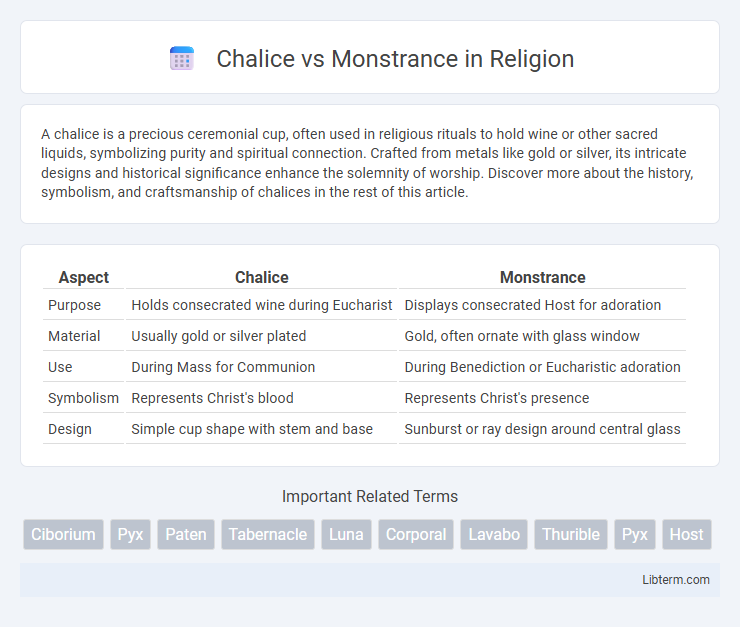A chalice is a precious ceremonial cup, often used in religious rituals to hold wine or other sacred liquids, symbolizing purity and spiritual connection. Crafted from metals like gold or silver, its intricate designs and historical significance enhance the solemnity of worship. Discover more about the history, symbolism, and craftsmanship of chalices in the rest of this article.
Table of Comparison
| Aspect | Chalice | Monstrance |
|---|---|---|
| Purpose | Holds consecrated wine during Eucharist | Displays consecrated Host for adoration |
| Material | Usually gold or silver plated | Gold, often ornate with glass window |
| Use | During Mass for Communion | During Benediction or Eucharistic adoration |
| Symbolism | Represents Christ's blood | Represents Christ's presence |
| Design | Simple cup shape with stem and base | Sunburst or ray design around central glass |
Introduction to Chalice and Monstrance
A chalice is a sacred cup used during the Eucharist to hold wine, symbolizing the blood of Christ in Christian liturgy. The monstrance is an ornate vessel designed to display the consecrated Eucharistic host for adoration and benediction, often featuring a sunburst design to highlight the presence of the Holy Sacrament. Both objects hold significant liturgical roles, emphasizing different aspects of worship in Catholic and Anglican traditions.
Historical Origins of the Chalice
The chalice originated in early Christian liturgical practices as a sacred vessel used to hold wine during the Eucharist, symbolizing the blood of Christ. Its design evolved from ordinary drinking cups to more ornate forms by the Middle Ages, reflecting its spiritual importance and craftsmanship. Unlike the monstrance, which developed later for displaying the consecrated host, the chalice's roots are deeply connected to the Last Supper and early Christian worship traditions.
Historical Development of the Monstrance
The monstrance, originating in the 14th century, developed as a liturgical vessel designed to display the consecrated Eucharistic host for public adoration, evolving from early reliquaries and pyxes used in medieval Christian worship. Its elaborate design, often featuring sunburst motifs, reflected the Church's emphasis on the doctrine of the Real Presence of Christ in the Eucharist, distinguishing it from the simpler chalice used for consecration and communion. Over centuries, regional artistic influences shaped monstrance styles, culminating in richly ornamented masterpieces that symbolize the height of Eucharistic devotion during the Counter-Reformation era.
Liturgical Functions: Chalice vs Monstrance
The chalice serves as the sacred vessel that holds the wine consecrated during the Eucharist, symbolizing the blood of Christ in the Mass. The monstrance, often a sunburst-shaped vessel, is used for Eucharistic adoration and benediction, displaying the consecrated host for worship outside of Mass. While the chalice is essential for Communion distribution, the monstrance facilitates reverence and adoration of the Blessed Sacrament.
Symbolic Meanings: Chalice and Monstrance in Christian Worship
The chalice in Christian worship symbolizes the cup used by Jesus at the Last Supper, representing the blood of Christ and the New Covenant in the Eucharist. The monstrance, often ornate and designed to hold the consecrated host, symbolizes the real presence of Christ in the Blessed Sacrament, facilitating adoration and devotion. Both serve as focal points in liturgical practices, with the chalice emphasizing sacrificial offering and the monstrance highlighting the mystery of Christ's enduring presence.
Materials and Artistic Designs of Chalices
Chalices are traditionally crafted from precious metals such as gold, silver, or gilt bronze to symbolize the sacredness of the Eucharist, often adorned with intricate engravings, gemstones, and enamel work that emphasize their ceremonial importance. The artistic design of chalices typically features a wide cup, a slender stem, and a broad base, incorporating religious motifs like crosses, saints, and biblical scenes to reflect their liturgical function. Unlike monstrances, which prioritize a transparent vessel for displaying the consecrated host, chalices focus on sturdy craftsmanship and ornate decoration to honor the ritual of communion.
Artistic Styles and Materials of Monstrances
Monstrances are often crafted with intricate Baroque or Gothic artistic styles, characterized by elaborate metalwork and ornate detailing that highlight their sacred function. Materials commonly used include gold, silver, and brass, frequently adorned with precious stones or enamel to enhance their visual and symbolic richness. These luxurious materials and styles distinguish monstrances from simpler chalices, emphasizing the monstrance's role in displaying the Eucharist for adoration.
Usage in Catholic Mass and Eucharistic Adoration
The chalice is primarily used in Catholic Mass to hold the wine that becomes the Blood of Christ during the consecration of the Eucharist, symbolizing the sacrifice of Jesus. The monstrance, on the other hand, is employed during Eucharistic Adoration to display the consecrated Host, allowing the faithful to visually and spiritually adore the Real Presence of Christ outside of Mass. Both sacred vessels serve distinct but complementary roles in the liturgical and devotional practices of the Catholic Church.
Key Differences Between Chalice and Monstrance
The chalice is a sacred vessel used in Christian liturgy to hold the consecrated wine during the Eucharist, symbolizing the blood of Christ, while the monstrance is designed to display the consecrated host for adoration and benediction. Chalices are typically cup-shaped and crafted from precious metals, emphasizing their role in Communion, whereas monstrances often feature ornate, sunburst designs with a glass enclosure to visibly showcase the Eucharist. The primary functional difference lies in the chalice's purpose for consumption during Mass versus the monstrance's role in exposition and veneration outside of Communion.
Importance of Chalice and Monstrance in Modern Liturgy
The chalice holds profound significance in modern liturgy as the sacred vessel used to consecrate and distribute the wine, symbolizing the blood of Christ during the Eucharist, central to Catholic worship. The monstrance serves a vital role in the adoration and exposition of the Blessed Sacrament, visually elevating the consecrated host for public veneration and deepening the faithful's spiritual connection. Both the chalice and monstrance are essential liturgical instruments that enhance the reverence, symbolism, and participatory devotion in contemporary Catholic rituals.
Chalice Infographic

 libterm.com
libterm.com